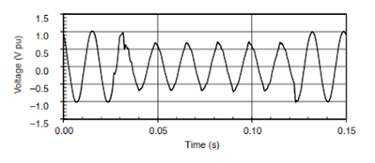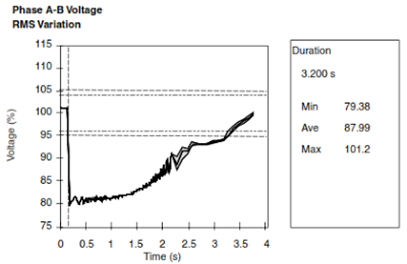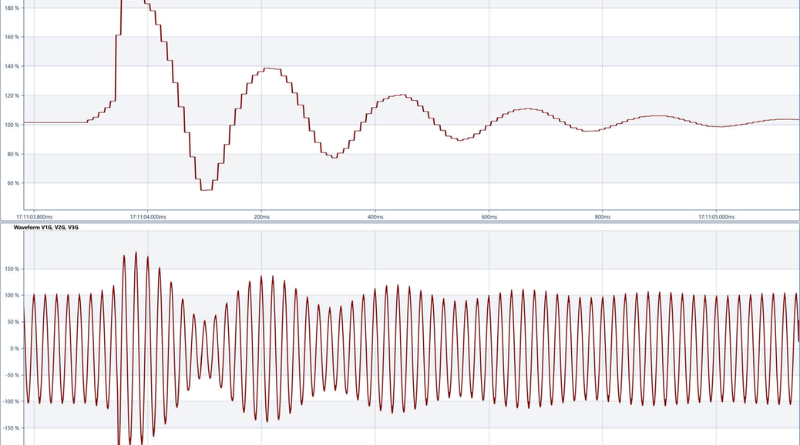
A voltage drop can decrease 0.1 to 0.9 PU in RMS current or voltage at line frequency over a period of 0.5 cycles to one minute. The power quality community has used the word “sag” to describe a short-term voltage drop for several years. Although the term has not been properly defined, it is increasingly accepted and used by manufacturers, dealers and end users. The IEC explanation for this phenomenon is “Dip”. The two terms are interchangeable, with “Say” being the most popular word in the US power quality community. The terms used to define the extent of a voltage drop are often confusing. A “20% drop” refers to a voltage drop that results in a voltage of 0.8 Pu or 0.2 Pu. The common term would leave little doubt as to the magnitude of the resulting voltage: “a voltage drop of 0.8 Pu” or “a voltage drop of 20% magnitude”. Unless otherwise noted, a voltage drop of 20% is considered an event where the effective voltage is attenuated by 20% to 0.8 pu. The base or nominal voltage level should also be like this.
Voltage drop due to SLG error
 RMS waveform for voltage drops
RMS waveform for voltage drops
 Voltage drop waveform
Voltage drop waveform
 Voltage drop waveform due to motor starting
Voltage drop waveform due to motor starting
In this illustration we see the effects of an oversized motor starter. An induction motor can draw almost 6 to 10 times its full load current during starting. If the current intensity is large in relation to the fault current available in the system at that time, the resulting voltage drop will be significant. In this case, the voltage immediately drops to 80% and then gradually returns to normal in about three seconds. Note the time difference between this and voltage drops caused by power grid failures.
The duration of voltage drops can be divided here into three categories: instantaneous, short-lived and transient, which corresponds to the three classes of interruptions and surges. These periods correspond to the typical operating times of utility protection equipment, as proposed by international technical organizations as continuous schedules.
Understanding Voltage Dips and Sags
Voltage sags and sags occur when the voltage supplied to an electrical system temporarily drops below standard levels. There are several reasons why power outages can occur, including lightning strikes, network failures, engine starts or the operation of heavy machinery. Although power outages are typically short, voltage drops can last longer and significantly affect sensitive electronic devices.
Consequences of voltage drops and sags
The consequences of voltage dips and sags can be far-reaching. In residential environments, this interference can damage household appliances, interrupt electronic devices and even cause data loss in computer systems. In industrial and commercial environments, the impact can be even more severe, causing production losses, equipment failures and financial losses. To effectively mitigate the risks associated with power outages and outages, it is important to clearly understand their potential impact.
Reduction of brownouts and voltage sags
Fortunately, several steps can be taken to mitigate the effects of power outages and outages. One approach is to install voltage regulators or uninterruptible power supplies (UPS) to stabilize power during outages. Advanced protective devices such as surge protectors and voltage drop correctors can protect sensitive equipment. Additionally, a thorough assessment of power quality and implementation of appropriate grounding techniques can contribute to a more robust electrical infrastructure.
Best Practices for Managing Voltage Sags and Sags
To effectively manage power outages and sags, it is important to establish a proactive maintenance and monitoring routine. Regularly inspecting electrical systems, identifying potential weaknesses and carrying out preventive maintenance can go a long way in minimizing the occurrence of malfunctions. Additionally, educating employees or family members about power outages and brownouts and their potential impacts can help raise awareness and enable quick action during such events.
Conclusion
Voltage sags and sags are inevitable aspects of our electrical systems. However, we can control these disturbances and ensure electrical stability by understanding their causes and consequences and implementing appropriate mitigation strategies. By taking proactive steps, educating ourselves, and investing in protective equipment, we can protect our home appliances, electronic devices, and industrial operations from the disruptive effects of voltage surges and sags.

